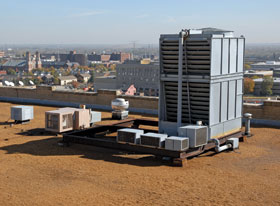

Regular maintenance can ensure that HVAC equipment remains efficient, but it could also cut energy costs. Part failure can seriously impact the performance of equipment, so it makes good sense to keep an eye on key components that have the greatest energy impacts. However, there are also significant benefits to be gained by switching to a whole-building-system approach, applying best practices and implementing effective scheduled maintenance.
Studies show that:
* Use of best practices in building maintenance and operations can reduce energy use by 10 to 20%.1
* Poor maintenance practices can increase energy use by 30 to 60%.1
* Programmes to enhance the efficiency of HVAC and lighting systems can decrease energy bills by 5 to 20% in commercial buildings2, without significant capital investment.3
* Effective scheduled maintenance can decrease energy bills by 15 to 20%.
As more studies show the benefits of a proactive approach and energy costs continue to climb, companies are stepping up their HVAC maintenance schedules even further, switching from a reactive ‘break-fix’ approach and from standard ‘scheduled maintenance’ practices prescribed by manufacturers to a predictive maintenance approach which bases maintenance on the actual condition of the machine.
A look at how common component performance issues in various types of chillers can degrade energy performance is a good incentive to begin to migrate to this approach, proactively monitoring performance and assessing the status of chiller components with the greatest energy impacts. Our top 10 are:

Centrifugal chillers
1. Dirty tubes – Microbes and the formation of scale or iron deposits in the chiller tube bundle reduce heat transfer. A water treatment program and tube cleaning could lead to a 10-15% saving in energy consumption.
2. Condenser flow rate – A 20% reduction in the condenser flow rate will increase full-load energy consumption by 3% in mechanical and absorption chillers used in chemical process cooling.
3. Oil contamination in refrigerant – There is a 2% loss in chiller efficiency for every 1% of oil found in the refrigerant. It is not uncommon to find 10% oil in the refrigerant of older chillers.
4. Sub-optimal refrigerant levels – Correcting refrigerant levels can provide up to 20% saving.
5. Leaks in the compressor can result in higher condenser pressure and temperature – About 1 psi of air in a condenser equates to a 3% loss in chiller efficiency.
Rooftop units
6. Economiser failure – Repair could deliver a 14 – 40% saving on energy consumption.
7. Airflow problems – Correcting to standard levels could deliver 10% savings.
8. Thermostat control problem – Correction could provide up to 40% savings.
9. Sensor problems – If a repair enables a non-functioning economiser, savings of up to 40% can be gained.
10. Suboptimal refrigerant charge – Correcting levels could lead to a 5 to 11% energy savings.
For a more detailed look at what could go wrong and how to fix it, see our Energy Savings from Maintenance fact sheet at http://www.institutebe.com/InstituteBE/media/Library/Resources/Existing%20Building%20Retrofits/Fact-Sheet-IBE-Energy-Savings-from-Maintenance.pdf
References:
1. Frankel, M., Heater, M. and Heller, J. 'Sensitivity Analysis: Relative Impact of Design, Commissioning Maintenance and Operational Variables on the Energy Performance of Office Buildings' New Buildings Institute. August 2012.
2. Portland Energy Conservation 1999c. Operation and Maintenance Assessments: A Best Practice for Energy-Efficient Building Operations. September 1999.
3. Chimack, M. J. Aardsma., D. Novosel. Energy Reduction through Practical Scheduled Maintenance. National Center for Energy Management and Building Technologies. November 2006.
For more information contact Johnson Controls, +27 (0)11 921 7141, Neil.Cameron@jci.com, www.johnsoncontrols.com

© Technews Publishing (Pty) Ltd. | All Rights Reserved.